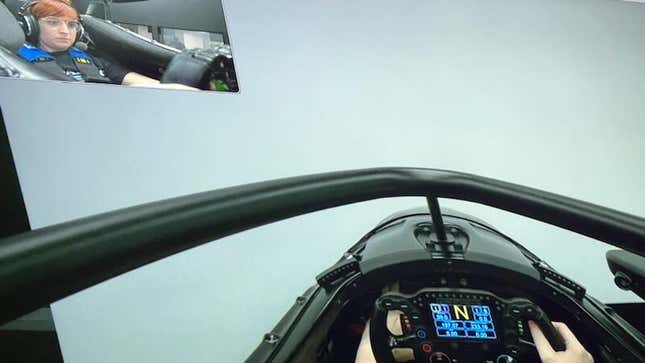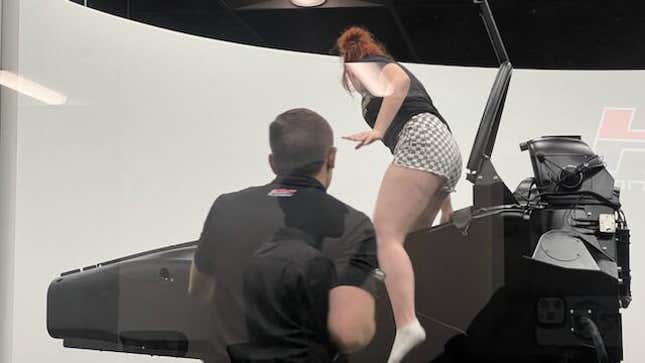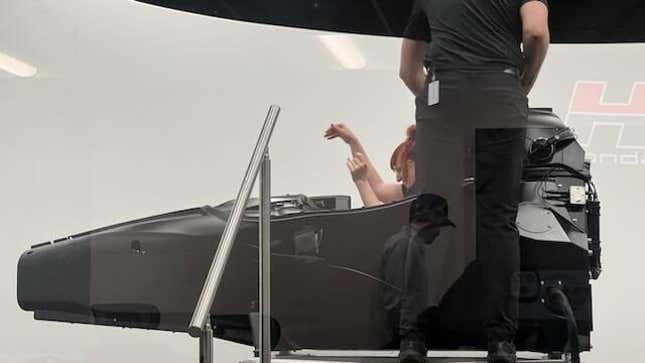I Tried Driving An Indy Car On Honda's Professional Racing Simulator And My Arms Still Hurt

I was approximately four crash-filled laps into my first stint behind the wheel of Honda’s latest and greatest professional Driver In Loop (DIL) racing simulator when I first noticed it: my arms ached, from fingertips to shoulder blades. As I binned it into the wall for the second time, I also realized I hadn’t breathed in about two minutes, my bangs were plastered to my head with sweat, and that the joints in my fingers creaked as I tried to release the steering wheel to wipe the palms of my hands on my shorts. Nope, I thought to myself, my iRacing practice absolutely did not prepare me for any of this nonsense.
It’s Penske Versus The World In The 2024 Indianapolis 500
Honda, one of the IndyCar’s two engine suppliers, brought me out the 108th running of the Indianapolis 500 for a variety of reasons. Yes, of course, we were there to see the race, but a few of us also had an opportunity to test the latest and greatest in simulated racing technology. It gave me a whole new appreciation for the effort it takes for the drivers to compete.
This particular simulator uses an old Indy car cockpit and features a 270-degree view from a 2.5-meter tall and nine-meter wide screen, with a full 360 degrees in yaw. Basically, with this machinery, drivers are able to more accurately replicate in-race conditions and make critical setup changes without actually having to field the expense of running real cars on real race tracks. It also represents a massive leap forward when compared to Honda’s previous sim, which went into service all the way back in 2013; the new version features multi-body vehicle dynamics physics simulation software and can generate up to 1.5 MB of data every single second. You can better simulate real-world conditions, make instant changes, and analyze reams of data and video recordings to understand how to improve. It’s a seriously impressive piece of machinery — and it’s also kind of terrifying.
When I found out we’d have a chance to try out Honda’s DIL sim, I started preparing in iRacing. Over the years, my husband has assembled a fairly decent sim rig, but we’re normal humans on a normal budget — so that means we haven’t spent several thousand dollars trying to create a rig that can replicate real-life conditions. I knew the Honda DIL sim would be exponentially more expensive, but I wanted to know exactly the kind of bang you’d be getting for your buck.
Photo: Jerry Perez
I think this is also a good time to admit that I’m not a racer, nor have I ever wanted to be one. I knew at a very young age that my brain is at its best when it has plenty of time to chew over various inputs and make an educated decision based on a slow reasoning process. I’ve never been good at first-person shooter video games that throw you into the thick of a battle zone, and I’ve always been a little terrified behind the wheel of the cars I’ve raced on tracks at performance driving schools. I’m not cut out for the whole “digest and respond to 1,000 variables flying at you in rapid speed” thing.
That’s tough for me, even on a normal-sized computer monitor. If I’m engaging in some iRacing shenanigans, I would prefer a road course with a slower, near-production vehicle; leaning how to put together a string of competent laps around an oval behind the wheel of an open-wheel machine, even virtually, was an exhausting prospect. I was proud of myself for setting some consistent 218 mph laps in qualifying trim… as long as I ignored the fact that the IndyCar drivers had actually qualified at 230+ mph the weekend before. I asked my husband to turn down the force feedback to a more manageable level, and I kinda-sorta got used to the sensation of lapping the 2.5-mile Indianapolis Motor Speedway. I capped off my excursion by finishing sixth in a 300-mile Indy race that’s part of my husband’s sim racing league — a feat I quite literally only accomplished by staying entirely out of everyone’s way and not getting caught up in crashes for position.
I can’t say I was confident as I climbed into Honda’s DIL sim, but I thought I at least had a decent shot of feeling somewhat competent.
Hooooo boy, was I wrong!

Locked in.Photo: Jerry Perez
If you know race cars, and especially open-wheel cars, then you know that the seating position is low and lounge-like. As a shorter gal, I sunk right into the cockpit and instantly lost a significant portion of my line of sight, simply because I couldn’t see over the lip of the tub. The adjustable pedals meant I could actually reach them comfortably, but my arms were at full extension holding the steering wheel, and my hands were too damn small to maintain a comfortable grip while doing things like pressing the radio button or releasing the clutch. I stalled my virtual Indy car countless times attempting to leave pit road because the moment I turned the wheel, the clutch paddle was entirely out of my grasp.
During my first few laps, I immediately attempted to channel my iRacing skillset onto the real thing and proceeded to crash, hard, several times into the wall. The DIL sim is set up in such a way that it shuts off feedback when you start making hard contact, but it was still fucking terrifying. When your field of vision is fully immersed by IMS, it’s hard to flip the switch in your brain that says you’ve just screwed up badly enough that you’re about to die. Try completing multiple 360-degree spins and then remember how to gently let off the clutch paddle as you head back onto the track for another attempt. It’s like trying to switch your brain from speaking French to Spanish when you’re only mildly proficient at understanding those languages.
After a few crashes, I realized I probably should not keep trying my balls-to-the-wall pace. I should slow down and actually try to come to terms with the simulator technology and the way it differed from my iRacing experience. The force feedback in the DIL sim’s steering wheel had been toned down significantly to give us journalists a shot at setting a decent lap speed in the cockpit of a car lacking power steering, but it was still way too aggressive for my weak jelly arms. I was shocked by how much I had to fight the wheel just to, say, keep the car in a straight line, or not immediately crash into the wall when exiting a corner. I have quite literally never experienced a sensation like it, and rather than the smooth inputs I’d been hoping to make, I felt like I just had to keep sawing at the wheel — even though I knew that was making the car more unstable and slowing me down. There was just no other way for me to control the Dallara chassis.

Photo: Jerry Perez
As I started turning consistent strings of (very slow) laps, I began to realize other problems. First, I had most definitely forgotten how to breathe, and it took my best yogi mindset to remind myself to link my breath with my motions: exhale into the corner, inhale on the straights. But by focusing on my breathing, I realized I was losing control of my racing line, and that I wasn’t exerting the necessary force to keep the car in a smooth trajectory. So, I had to remind myself to not just exhale into the corners, but to use my left hand to tug the steering wheel down to my thigh, while my right hand attempted to stabilize the wiggles. Oh, yeah, and then I had to inhale on the straights — and I also definitely needed to let the car sweep out closer to the wall, even though I couldn’t see the wall, and even though that was extremely terrifying, and even though it was hard to keep the car in place. But thinking about all that meant the first corner arrived as a surprise; I turned in later than I wanted, had to lift off the throttle more than intended, and realized just how easy it was for a single corner to ruin your entire lap. I spent the rest of that lap trying to make up for the way I beefed the first turn. It took another two laps before I finally felt like I’d gotten back into a normal flow.
But do you know what happened as soon as I felt kind of competent about my racing line again? I began to realize how badly my arms were aching. My already-nonexistent grip strength had entirely disintegrated, which meant I had to actively consider how I was going to hold the wheel. I had to remind myself to grip harder, but that tension spread up my forearms, through my biceps, and back to my shoulder blades. When the DIL sim engineers let me know that I’d completed five consecutive laps, my only thought was, “What the fuck.” I was already exhausted, and if this were a real race, there would still be 195 laps left to go.
I managed to string together about 10 consecutive laps before I just couldn’t hold on anymore. The rear of the car twitched, and I couldn’t catch it. I ended my professional sim excursion in the wall.

Photo: Jerry Perez
The rig slowly tracked back to its locked-in entry and exit position, and I took stock. I had to remind my fingers how to let go of the steering wheel. Doing so released tension I hadn’t realized I’d been holding, and my upper body muscles trembled. I was drenched in sweat, my knees were shaky, and it also kinda felt like the bottom of my stomach had dropped away, leaving me a little husk without a single thought in her head aside from, “Oh my god.” In the aftermath, I struggled to release the safety belts, tie my shoes, open my water bottle, and breathe.
I can’t compare Honda’s new sim to its old one, since I didn’t drive the old one. I can’t compare Honda’s new sim to its Indy race car, because I immediately learned that I have no interest in driving a real Indy race car. I can only compare Honda’s new sim to iRacing, and in all honesty, it doesn’t even compare — not with the at-home rig I have access to.
Beyond anything else, it gave me a much deeper appreciation for the sheer amount of effort the Indy 500 requires. Anyone who follows racing has easily heard how drivers aren’t athletes because the car is in control, or that oval racing is simple because it’s all about turning left. I’m absolutely aware that those sentiments are bullshit — but now I have a far greater appreciation for the physical effort it takes just to turn some deeply uncompetitive laps: It’s been three days since my test, and my arms still haven’t recovered.


